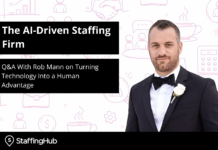
By George Lessmeister, CEO and founder of LGC
It’s the time of year when business leaders in various sectors make predictions for the New Year. Taking a look in the rearview mirror, we have to remember—businesses have experienced as much disruption in the past five years as the previous 25. As a result, the “zero consumer” has emerged.
And these zero consumers are the same people making up today’s labor pool, so understanding their priorities can help employers develop strategies to improve hiring and retention in coming months. Here’s how that concept could affect 2024 hiring trends.
What is a zero consumer?
Contrary to how it sounds, the term “zero consumer” doesn’t refer to people who don’t buy anything. Instead, it describes buyers whose behavior includes zero patience with long delivery times, zero brand loyalty, and concerns for net zero (sustainability). These attributes don’t just apply to outliers; they describe the values and buying habits of today’s average consumer.
The zero consumer concept applied to staffing
The 2024 labor market will still be challenging, so employers will have to work hard to attract good candidates, much like retailers must work to attract customers. Savvy employers will think of their candidates more like consumers and address their priorities in the hiring process.
A bonus to that approach? Keeping those applicants as customers. A 2023 talent study found that 56% of respondents would be less likely to patronize a brand if they had a bad experience applying for a job with that company. Keeping applicants happy – even those who aren’t hired – is good for the bottom line.
Increased pay transparency
Just as consumers have zero patience for delay, applicants have zero patience for hiring processes they feel undervalue their time and worth. Pay transparency – already present in half of postings on Indeed – will be a growing trend, as more governmental bodies mandate it and more job seekers demand it. Applicants expect pay transparency because they don’t want to spend time applying for a position that doesn’t meet their compensation needs.
Faster hiring and onboarding
To speed up hiring, employers increasingly will be using technology in their applications and onboarding processes. Examples from an iCims study show how two major chains are embracing that trend.
The Cheesecake Factory pared down their mobile application from nine pages to two, and completion rates went from 39% to 71%. Wendy’s launched a chatbot named “Patty” that reduced the time to apply and schedule an interview to two minutes. As a result, the median time from application to hiring shrank to five days for 80% of applicants and hiring increased by 8% in three months.
Virtual onboarding is on the rise. Online training modules, which can be completed anywhere, anytime, give new hires the flexibility to learn at their own pace and address the growing “zero patience for delay” mindset. They also streamline a company’s HR workload.
The use of AI by both talent managers and applicants is expected to increase. HR managers can use AI for time-consuming assessments and scheduling, as well as for drafting job descriptions. Applicants are increasingly using AI to create resumes that better match job postings and highlight their skills.
Hiring for growth
In 2024, the applicant pool is likely to be somewhat larger, and that will bring with it increased focus on hiring for long-term growth. Employers will be looking for candidates who are a good fit, not just a warm body. More employers will be using temp-to-hire arrangements in which the temporary work period is a sort of on-the-job interview. Increasingly, employers are looking for skill sets, not necessarily education. They prioritize candidates with multiple skills, such as language proficiency and AI experience, so they can fill multiple roles, making the company’s payroll dollars go further.
More gig workers
Just as zero consumers do not want to tie themselves to brands, today’s workers – especially Gen Z and Millennials – are increasingly willing to accept temporary and temp-to-hire positions. Some see it as an opportunity to test-drive an employer before making the commitment to permanent employment. Others embrace gig work to gain flexibility in their work scheduling.
Continuing scrutiny of worker classification
The coming year is likely to bring more attention to the issue of worker classification. Online staffing platforms that provide workers as 1099 independent contractors are undergoing greater scrutiny by governmental agencies. These platforms can offer workers at a lower cost than traditional staffing companies because they don’t pay for workers compensation insurance or withhold payroll taxes. This practice leaves clients exposed to potential liability for back wages, fines, and insurance claims. Once a concern primarily of the hospitality and warehouse industries, this issue is now being hotly debated in healthcare regarding the classification of temporary nursing staff.
 George Lessmeister is CEO and founder of LGC, a national staffing firm headquartered in Indianapolis. LGC has offices in over 40 U.S. cities. Team members work with employers in a variety of industries to place executive and temporary workers.
George Lessmeister is CEO and founder of LGC, a national staffing firm headquartered in Indianapolis. LGC has offices in over 40 U.S. cities. Team members work with employers in a variety of industries to place executive and temporary workers.





